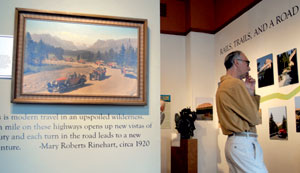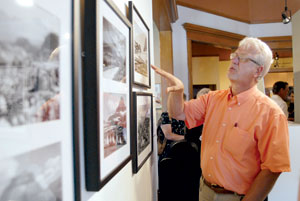Last Friday, the National Park Service gathered with the public at Lake McDonald Lodge to honor the 75th anniversary of Glacier National Park’s Going-to-the-Sun Road. The event, complete with local singers, Native American drummers, several guest speakers and a cake, too, was similar to the dedication ceremony held in the summer of 1933, where about 4,000 people gathered to open the pass from West Glacier to St. Mary.
At Kalispell’s Hockaday Museum of Art, though, artists and local citizens celebrated the road through a different lens last week, recognizing both the history of the road and the artistic influence of the national park.
“The lineage of artists in the park goes on and on,” Lucy Smith, development director at the museum, said. “The Going-to-the-Sun Road is a marvel of engineering and a historic landmark, but it also has a history – along with the rest of the park – of being a cultivating place for art.”
The local art museum always features a permanent collection called “Crown of the Continent,” with a rotating display of some of its 600-plus Glacier Park art pieces and collectibles, as part of its mission to “preserve the art and culture” of the park. Through mid-October, though, the museum will expand that usual collection in honor of the road’s anniversary.
 |
|
Standing near T.J. Hileman’s photograph of early touring buses, Alex Hasson browses digital block prints by Roy Hughes at the Hockay Museum of Art’s celebration. |
“Rails, Trails and a Road” includes historic photographs and video footage of the building of the Sun Road along with a large collection of paintings by renowned Glacier Park artists like John Fery, Adolph Heinz and Joseph Abbrescia. Paintings and photographs by contemporary artists like Mark Ogle, Monte Dolack, Nancy Dunlop Cawdrey and Linda Tippetts round out the display.
As locals wandered through the collection at the opening last Thursday, they marveled at several examples of some of the first recorded park-inspired art pieces: brochures, maps, calendars and paintings commissioned by the Great Northern Railroad Company.
During its reign in the park, the railroad wanted to fill its new Empire Builder westbound route with wealthy travelers from the East Coast, and set about luring them away from tours to Europe with a “See America First!” campaign. Brochures in the museum’s collection beg tourists to heed “the call of the mountains,” by visiting “where the American and Canadian Rockies meet” or “the Switzerland of America.”
As part of its marketing strategy, the Great Northern hired artists from Europe and the United States to showcase the wonders of the park; also, inadvertently creating scores of paintings and photographs that chronicled the parks earliest years and spawning a colony of artists that would continue for generations. “Of course, the beauty of the park is its own artistic draw, but the railroad certainly played a significant role,” Smith said.
Whereas the railroad opened the park to visitors and artists, it was the creation of the Going-to-the-Sun Road that furthered their reach into the park’s more hidden vistas. When the road opened in 1933, park visitors increased from 53,202 the previous year to 76,615 visitors – despite the economic impact of the Great Depression. By 1936, more than 210,000 people were traveling through Glacier, according to the exhibit.
 |
|
Bill Dakin views photographs taken during the Going-to-the-Sun Road’s opening ceremony in 1933. |
“It got us up there,” artist Mark Ogle said. “The road created the potential to pull out at 100 different places, take out an easel and paint the most incredible scene. It is a pivotal part of artists painting up in the park today.”
For oil painter Linda Tippetts, the Going-to-the-Sun Road is an exception to her painting rules. “My true love is painting raw nature without props in it,” she said. “However the road is so well designed and built that it blends in with nature like it belongs there; it fits like a glove.”
The road and the park also offer a challenge that’s hard for the artist to avoid.
“It’ll never let you down,” Tippetts said. “It’ll defeat you, but it doesn’t ever let you down.”
By running the exhibit through the summer, Smith said, the museum hopes to supplement locals’ and tourists’ trips through the park. The display uses the park’s artistic legacy, she added, to also educate visitors on the area’s history.
“People can come in and see these beautiful paintings and learn about the history of the road and the park, and then go up and experience those places for themselves,” she said.